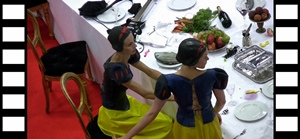













Harold: Last night, when I plugged into my brain socket, I chose to virtually experience visits to great works of art throughout human civilization.Judge the likelihood for yourself.
Melvin: How clever of you! See anything you liked?
Harold: A few things – the reconstructed Colossus of Rhodes was pretty cool, and that Sistine Chapel thing was really colorful. But that 2010 black-and-white video of the naked woman with the barbed-wire hula-hoop! Now there's a masterpiece!





















